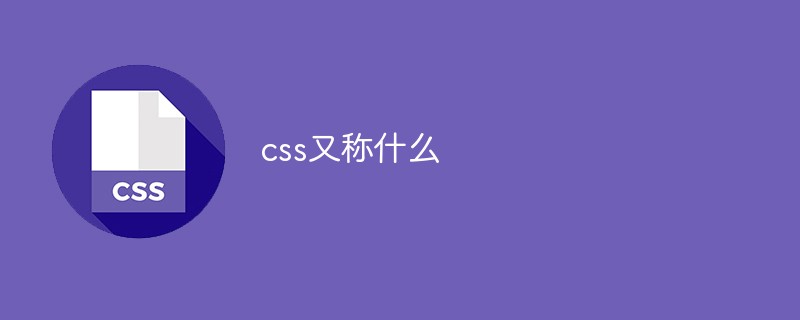
The full English name of css is Cascading Style Sheets, which means cascading style sheets, also known as string style lists, cascading style sheets, cascading style sheets, and hierarchical style sheets. It is a type of structured document. Computer language that adds style.

The operating environment of this article: Windows 7 system, CSS3 version, Dell G3 computer.
What is css also called?
Cascading Style Sheets (English: Cascading Style Sheets, abbreviation: CSS; also known as string style list, cascading style sheet, cascading style sheet, hierarchical style sheet) is a type of style sheet used to create A computer language for adding styles (fonts, spacing, colors, etc.) to structured documents (such as HTML documents or XML applications), defined and maintained by the W3C. CSS is divided into different levels: CSS1 is now obsolete, CSS2.1 is a recommended standard, and CSS3 is divided into small modules and is being standardized. CSS3 is now supported by most modern browsers, while the next version, CSS4, is still under development.
css language features
CSS provides a style description for the HTML markup language and defines the display mode of the elements. CSS is a breakthrough in the field of web design. It can be used to modify a small style to update all page elements related to it.
In general, CSS has the following characteristics:
Rich style definition
CSS Provides a rich document style appearance, as well as the ability to set text and background properties; allows the creation of a border for any element, as well as the distance between the element border and other elements, as well as the distance between the element border and the element content; allows the text size to be changed at will Writing style, decoration style and other page effects.
Easy to use and modify
CSS can define styles in the style attribute of HTML elements or in HTML documents. In the header part, the style can also be declared in a special CSS file for reference by the HTML page. In short, CSS style sheets can store and manage all style declarations in a unified manner.
In addition, elements of the same style can be classified and defined using the same style, you can also apply a certain style to all HTML tags with the same name, or you can assign a CSS style to a certain in page elements. If we want to modify the style, we only need to find the corresponding style statement in the style list and modify it.
Multi-page application
CSS style sheet can be stored in a separate CSS file, so that we can use the same A CSS style sheet. Theoretically, CSS style sheets do not belong to any page file and can be referenced in any page file. In this way, the styles of multiple pages can be unified.
Cascading
Simply put, cascading is to set the same style multiple times on an element, which will use the last attribute value set. . For example, if you use the same set of CSS style sheets for multiple pages in a site, and if you want to use other styles for some elements in some pages, you can define a separate style sheet for these styles and apply them to the page. These styles defined later will override the previous style settings, and what you see in the browser will be the style effect set last.
Page compression
In websites that use HTML to define page effects, a large number or repeated tables and font elements are often required to form various specifications. The result of this is that a large number of HTML tags will be generated, which will increase the size of the page file. Putting the style declaration separately in the CSS style sheet can greatly reduce the size of the page, so the time spent loading the page will also be greatly reduced. In addition, the reuse of CSS style sheets reduces the size of the page to a greater extent and reduces the download time.
Recommended learning: "css video tutorial"
The above is the detailed content of What is css also called?. For more information, please follow other related articles on the PHP Chinese website!